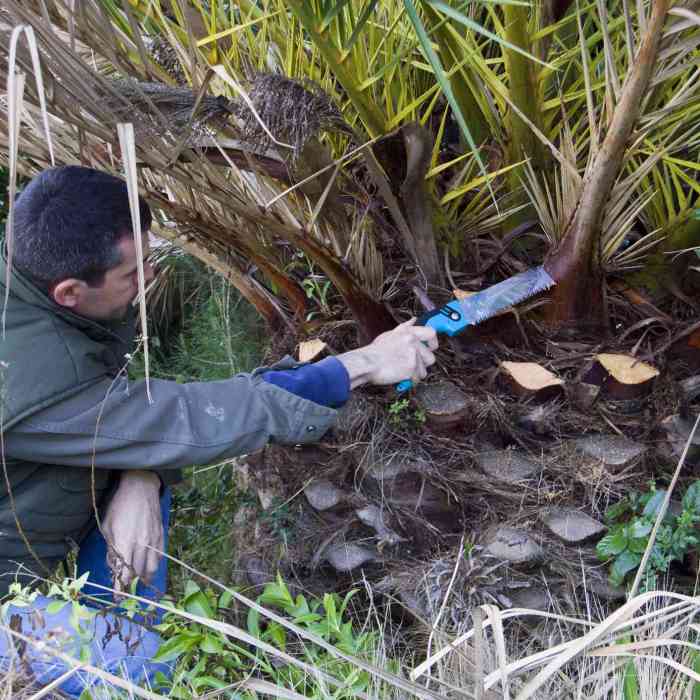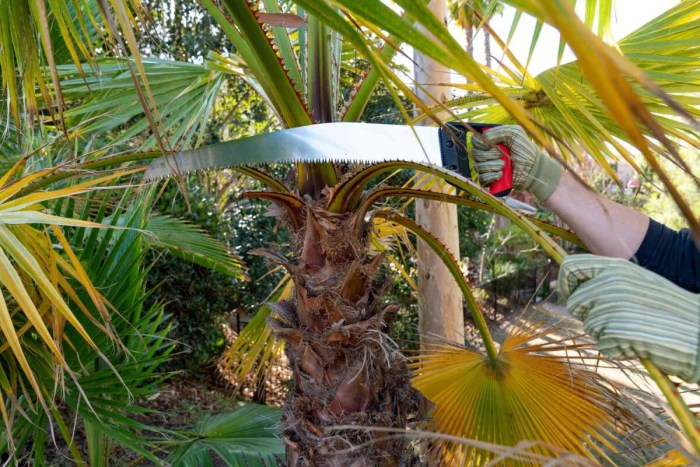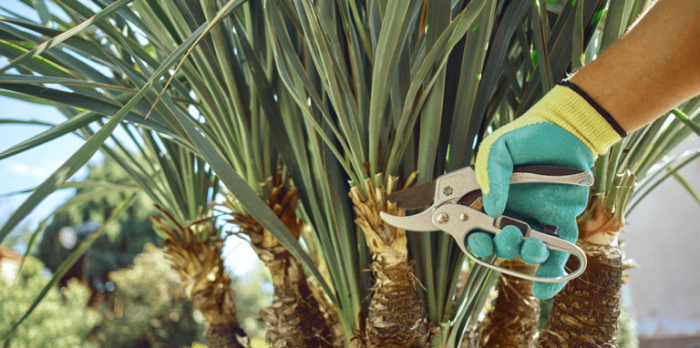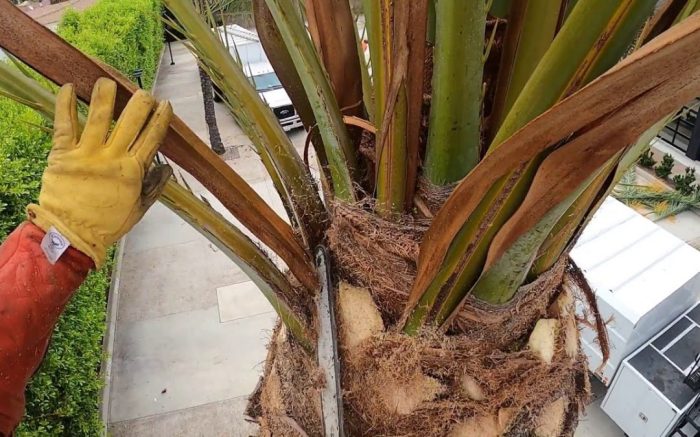How to trim palm plants is a comprehensive guide that provides detailed instructions and insights into the art of palm tree trimming. This guide covers everything from the basics of palm trimming to advanced techniques for enhancing the aesthetics of your palm trees.
Whether you’re a seasoned gardener or a novice looking to keep your palm trees healthy and looking their best, this guide has something for you. Dive in and discover the secrets to proper palm tree trimming.
Techniques for Trimming Palm Plants

Maintaining the health and aesthetics of palm plants requires regular trimming. Proper trimming techniques, sharp tools, and an understanding of the specific needs of different palm varieties are essential for successful palm care.
Using Sharp Tools and Pruning Techniques
Sharp, clean tools are crucial for precise and healthy trimming. Use bypass pruners for small stems and branches, and loppers or a pruning saw for larger ones. Make clean cuts at a slight angle to prevent water accumulation and promote healing.
Benefits of Regular Trimming
Regular trimming removes dead or damaged fronds, improves air circulation, and promotes new growth. It also reduces the risk of disease and pests, enhances the plant’s overall appearance, and maintains its shape and size.
Palm plants, with their lush fronds, add a touch of the tropics to any space. Trimming them regularly keeps them healthy and looking their best. To trim a palm plant, simply remove any brown or yellow leaves at the base of the plant.
You can also trim the tips of the fronds to shape them. For more ideas on how to add greenery to your home, check out our article on 10 Hanging Plants to Elevate Your Rental Apartment . Once you’ve trimmed your palm plant, it will be ready to enjoy for months to come.
Types of Palm Plants and Their Trimming Needs
Palm plants come in a wide variety of species, each with its own unique trimming requirements. These requirements are influenced by factors such as growth patterns, leaf types, and environmental factors.
Growth Patterns
Palm plants can be divided into two main growth patterns: single-stemmed and multi-stemmed. Single-stemmed palms, such as the areca palm, grow with a single trunk. Multi-stemmed palms, such as the lady palm, grow with multiple trunks.
Single-stemmed palms typically require less trimming than multi-stemmed palms. This is because the single trunk does not produce as many new leaves as multiple trunks.
Leaf Types
Palm plants also have different types of leaves. Some palms, such as the fan palm, have fan-shaped leaves. Others, such as the feather palm, have feather-shaped leaves.
Trimming a palm plant requires removing dead or damaged fronds, which can help promote new growth. For detailed instructions and tips on how to trim palm plants, refer to our comprehensive guide. Additionally, if you’re looking to enhance your designs with realistic greenery, check out 10 Hanging Plants Revit Family Free Download: Enhance Your Designs with Realistic Greenery for a collection of free Revit family downloads that can bring your projects to life.
Trimming your palm plants regularly will not only improve their appearance but also contribute to their overall health and vitality.
Fan-shaped leaves are typically easier to trim than feather-shaped leaves. This is because the fan-shaped leaves are less likely to get tangled.
Environmental Factors
Environmental factors can also affect the trimming needs of palm plants. For example, palms that are grown in windy areas may require more trimming than palms that are grown in sheltered areas.
Wind can cause the leaves of palm plants to become damaged. This damage can make the leaves more susceptible to disease and pests.
Trimming Needs of Various Palm Species
The following table summarizes the trimming needs of various palm species:
| Palm Species | Growth Pattern | Leaf Type | Trimming Needs |
|---|---|---|---|
| Areca Palm | Single-stemmed | Fan-shaped | Low |
| Lady Palm | Multi-stemmed | Feather-shaped | Moderate |
| Fan Palm | Single-stemmed | Fan-shaped | Low |
| Feather Palm | Single-stemmed | Feather-shaped | Moderate |
Tools and Equipment for Palm Trimming
Palm trimming requires specific tools and equipment to ensure efficient and safe execution. Essential items include pruning shears, saws, and other specialized tools.
Pruning Shears
Pruning shears are handheld tools specifically designed for cutting palm fronds and branches. They come in various sizes and shapes, depending on the thickness and toughness of the material being cut. Bypass shears feature two sharp blades that pass by each other, providing a clean cut with minimal damage to the plant.
Anvil shears, on the other hand, have one sharp blade that cuts against a flat surface, ideal for cutting thicker stems.
Trimming palm plants involves removing dead or damaged fronds, which enhances the plant’s health and aesthetics. For inspiration on beautifying your home with greenery, consider exploring 10 Hanging Plants Pinterest: Beautify Your Home with Greenery . Once you’ve added some greenery to your space, return to trimming your palm plant to maintain its optimal condition.
Saws, How to trim palm plant
Saws are necessary for removing large or thick branches that cannot be cut with shears. Pruning saws have curved blades designed to cut on the pull stroke, minimizing damage to the palm. Bow saws are commonly used for larger branches, while pole saws extend the reach for trimming taller palms.
Other Tools
Additional tools can enhance the trimming process. A ladder or platform provides a safe and stable surface for working at height. Gloves protect hands from sharp edges and debris. A broom or blower helps remove cut fronds and debris from the work area.
To keep your palm plant healthy and looking its best, regular trimming is essential. Start by removing any dead or yellowed leaves. Next, prune any stems that are growing too long or out of shape. For best results, use sharp, clean shears and make clean cuts.
If you’re looking for a wide variety of plants and gardening supplies, check out plants bunnings . They have everything you need to keep your plants thriving, including a great selection of palm plants. To finish trimming your palm plant, remove any suckers or offshoots that may be growing at the base of the plant.
Selecting and Maintaining Tools
Selecting the right tools depends on the size and type of palm being trimmed. Choose sharp, high-quality tools that are appropriate for the task. Regular maintenance is crucial to ensure optimal performance. Keep tools clean and lubricated, and sharpen blades as needed.
By using the appropriate tools and equipment, palm trimming can be performed safely and effectively.
Safety Considerations for Palm Trimming

Palm trimming is a crucial task for maintaining the health and appearance of these majestic plants. However, it also comes with inherent risks that must be addressed to ensure the safety of both the trimmer and those around them.
Sharp tools, falling debris, and electrical wires pose significant hazards during palm trimming. It is essential to take appropriate precautions to minimize these risks.
Accessing and Trimming Elevated Palms
- Proper Equipment:Use a sturdy ladder or tree climbing gear to access elevated palms safely.
- Secure Footholds:Ensure a stable and secure footing before attempting any trimming.
- Clear Work Area:Remove any obstacles or debris from the work area to prevent tripping or falling.
- Safety Harness:Consider using a safety harness when working at heights, especially for larger palms.
Creative Trimming Techniques for Palm Plants: How To Trim Palm Plant

Beyond basic trimming, creative techniques can elevate the aesthetic appeal of palm plants. Topiary, shaping, and decorative pruning transform them into captivating works of art.
Topiary
Topiary involves shaping the plant into intricate forms, such as animals, geometric shapes, or even human figures. Skilled topiarists use shears and wire frames to create these masterpieces, adding a touch of whimsy to any landscape.
Shaping
Shaping refines the natural form of the palm, enhancing its silhouette. This technique involves removing excess fronds and shaping the remaining ones to create a desired effect, such as a graceful arch or a cascading waterfall.
Decorative Pruning
Decorative pruning adds a touch of artistry by highlighting specific features of the palm. This technique involves removing selected fronds to create patterns, such as stripes, spirals, or geometric shapes. The result is a visually striking plant that draws attention to its unique characteristics.
Final Conclusion

In conclusion, trimming palm plants is an essential aspect of maintaining their health and beauty. By following the techniques Artikeld in this guide, you can ensure that your palm trees thrive and add a touch of tropical elegance to your landscape.
Remember to prioritize safety, use the right tools, and adapt your trimming techniques to the specific needs of your palm species. With a little care and attention, you can keep your palm trees looking their best for years to come.
Answers to Common Questions
How often should I trim my palm tree?
The frequency of trimming depends on the species of palm tree and its growth rate. Generally, it’s recommended to trim palm trees once or twice a year, or as needed to remove dead or damaged fronds.
What tools do I need to trim my palm tree?
Essential tools for palm trimming include sharp pruning shears, a pruning saw, and a ladder. For taller palm trees, you may also need a pole pruner or a cherry picker.
How do I safely trim a palm tree?
Always wear safety glasses and gloves when trimming palm trees. Assess the tree for any hazards, such as dead fronds or electrical wires. Use a ladder or pole pruner to access higher fronds, and make sure to have a spotter if necessary.